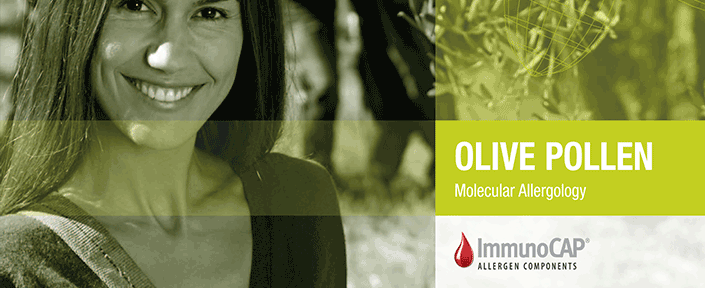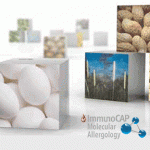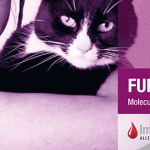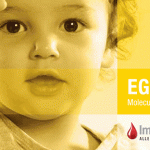New Levels of Allergy Management: Olive Components
Products are for professional/laboratory use only.
An allergy diagnosis is based on the history, clinical symptoms and physical examination of the patient in combination with results of sIgE tests.
ImmunoCAP® Molecular Allergology takes the diagnosis and management of allergy to a whole new level. The technology uses single allergen components to quantitatively detect IgE antibodies. A single blood sample enables measurement to all available ImmunoCAP components, providing precise results for better risk assessment. ImmunoCAP Allergen Components help differentiate “true” allergies from symptoms due to cross-reactivity, evaluate the risk of severe reactions and help in defining the optimal specific immunotherapy treatment. Benefits that ultimately can improve the patient’s quality of life.
Sensitization to olive pollen normally varies between 5–40 % in olive pollen areas.
The presence of at least 20 proteins with allergic activity has been demonstrated in Olive pollen. However, more than 70 % of patients with sensitization to olive pollen have IgE antibodies to Ole e 1.
The frequency of sensitization to Ole e 7 and Ole e 9 varies strongly between different areas (0–50 %). Sensitization to the cross-reactive allergens profilin, polcalcin and CCD is usually less frequent (< 20 %).
In addition to being a major olive pollen allergen, Ole e 1 is also a marker for sensitization to ash pollens, as well as privet,and lilac pollens since they are closely botanically related.
Ole e 7 is a non-specific lipid transfer protein (nsLTP) with limited homology and cross-reactivity to other nsLTPs. Sensitisation to Ole e 7 has been associated with a propensity to adverse reactions.
Ole e 9, has been shown to be a major allergen of olive pollen, and may play a role in pollen-latex-fruit syndrome.
Olive pollens can induce asthma, allergic rhinitis and allergic conjunctivitis in sensitised individuals. A well-founded olive pollen diagnosis and proper immunotherapy can reduce allergic symptoms and improve the quality of life of the patients.
References:
Barber, D. et al. Understanding patient sensitization pro les in complex pollen areas: A molecular epidemiological study Allergy 2008; 63 (11): 1550–1558.
Barber D, et al. Degree of Olive Pollen Exposure and Sensitization Patterns. Clinical Implications. J Investig Allergol Clin Immunol 2007; Vol. 17, Supplement 1: 63–68.
Castro AJ, et al. Pla 1 1 and Ole e 1 pollen allergens share common epitopes and similar ultrastructural localization. J Investig Allergol Clin Immunol 2007; 17 Supplement 1, pp. 41–47.
Cuesta-Herranz J, et al. Differences among pollen-allergic patients with and without plant food allergy. Int Arch Allergy Immunolog 2010; 153: 182–192.
García, B.E. et al. Oleaceae-induced pollinosis in an area with exposure to olive and ash trees. Journal of Investigational Allergology and Clinical Immunology 2011; 21 (1): 34–37.
Hauser M. et al. Pan allergen sand their impact on the allergic patient. Allergy, Asthma & Clinical Immunology 2010; 6(1): 1–14.
Quiralte J, et al. Modelling diseases: The allergens of Olea europaea pollen. J Investig Allergol Clin Immunol 2007; 17 Suppl 1:24–30.
Rodríguez R, et al. Olive pollen recombinant allergens: value in diagnosis and immunotherapy. J Investig Allergol Clin Immunol 2007;17 Suppl 1:4–10.
Rossi, R.E., et al. Sensitization pro les in polysensitized patients from a restricted geographical area: Further lessons from multiplexed component resolved diagnosis. 2011, European Annals of Allergy and Clinical Immunology 43 (6), pp. 171–175.
Schmid-Grendelmeier P. Recombinant allergens. For routine use or still only science? Hautarzt 2010; 61(11): 946–53.
Tordesillas, L., et al. Plant lipid transfer protein allergens: No cross-reactivity between those from foods and olive and Parietaria pollen. International Archives of Allergy and Immunology 2011; 156 (3): 291–296.
Valenta R, Twaroch T, Swoboda I. Component-Resolved Diagnosis to Optimize Allergen-Speci c Immunotherapy in the Mediterranean area. J Invest Allergol Clin Immunol 2007; Vol 17, supplement 1:88–92







